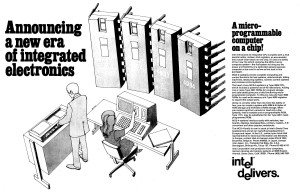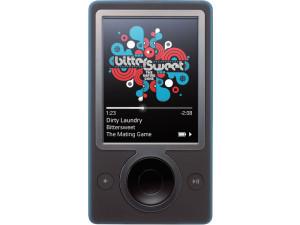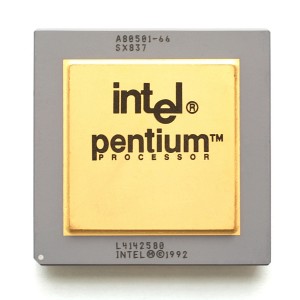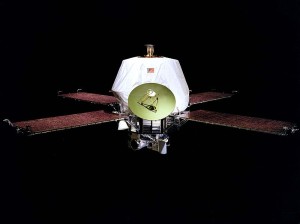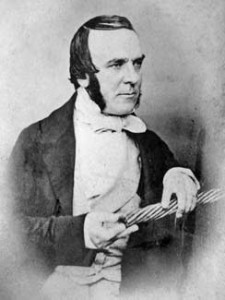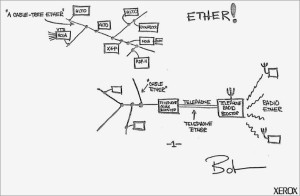Archive for 2024
The Dawn of the Microprocessor
An advertisement in the magazine Electronic News announces the Intel 4004, the first commercially available microprocessor. The 4004 was primarily used in calculators, the first being the Busicom 141-PF. In fact, it was Busicom that actually developed the design of what would become the Intel 4004. Busicom approached Intel to help them finalize the design and manufacture their “calculator engine”. Intel’s engineers reduced the 12 integrated circuit design Busicom had come up with to 4 ICs and delivered the finished product in January 1971. Busicom had exclusive rights to that design until later in that year, when Busicom and Intel renegotiated their contract with Intel lowering their prices to Busicom in exchange for rights to the design of the microprocessor.
By offering the first general-purpose programmable processor to the general market, Intel spurred the rapid development of electronic devices in the 1970s, culminating in the development of personal computers during that decade. However, Intel wasn’t the clear leader in the microprocessor market until the IBM PC and clones helped catapult Intel to that title in the 1980’s.
Microsoft Introduces Zune
Knock-knock
Who’s there?
Microsoft Zune.
Microsoft Zune who?
Exactly.
Microsoft releases their Zune media player, intended to compete with Apple’s iPod. Hailed by some as an “iPod-killer”, the only killing done was by Microsoft less than 5 years later when they ended production of the Zune brand. Otherwise known as simply another media player to fall to the iPod behemoth, the Zune is considered a spectacular failure when taking into account the weight of the Microsoft brand at the time. The Zune’s lack of success foreshadowed of the decline of Microsoft in The New World of Technology, once Apple introduced the iPhone and iPad effectively ending the PC Era.
Intel Bugs Out
One week after reports surfaced identifying a flaw in certain Pentium processors, Intel releases a software workaround for operating systems to avoid the commonly named “F0 bug“. A very specific invalid operation passed to the affected processors would cause the processor to lock up, causing the computer and any software running on it to freeze. Identified by Intel as the “Invalid Operand with Locked Compare Exchange 8Byte (CMPXCHG8B) Instruction Erratum” (seriously?), the flaw, while potentially a serious problem, was practically little more than a PR headache as the invalid operation that triggered the processor to lock up was never encountered in real-world operations. Additionally, the F0 bug only affected the older Pentium processors, not the Pentium II and Pentium Pro processors Intel was currently shipping at the time. However, the workaround was necessary as malicious software could have exploited the flaw and caused serious problems for PCs and servers using the affected processors.
Mariner 9 Orbits Mars; First Spacecraft to Orbit Another Planet
NASA’s Mariner 9 reaches the planet Mars and becomes the first man-made object to orbit another planet. Mariner 8 was scheduled to be the first, however due to launch problems it failed to make it out of Earth’s atmosphere. The Soviet Mars 2 and Mars 3 space probes reached the planet on November 27 and December 2 respectively.
Mariner 9 completed its mission of photographing the surface of Mars, transmitting 7,329 images covering 100% of the planet’s surface. While out of fuel, Mariner 9 still orbits Mars to this day, expected to stay in orbit until about the year 2022 when it will enter the planet’s surface and either burn up or crash into the surface.
First Underwater Telegraph Cable
Laid by British telegraphic engineer John Watkins Brett and his brother Jacob Brett, the world’s first operational underwater telegraph cable opens for business. Connecting the English city of Dover to the French city of Calais, the cable was ran at the narrowest point of the English channel. With this link, communication between London and Paris was made possible.
Microsoft Declares Tablets Are the Future
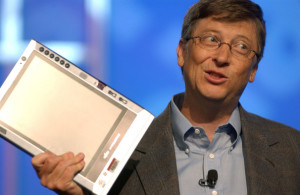
Bill Gates demonstrates a functional prototype of a Tablet PC. Microsoft claims “the Tablet PC will represent the next major evolution in PC design and functionality.” However, the Tablet PC initiative never really takes off and it isn’t until Apple introduced the iPad in 2010 that tablet computing is widely adopted.
In my opinion, Microsoft’s failure with the Tablet PC initiative was threefold. First, they simply tried to adapt Windows, an operating system designed for use with a keyboard and mouse, for use with a touchscreen/pen interface. Users never really warmed up to the awkward hybrid interface. Second, by their own words they were “incorporating the convenient and intuitive aspects of pencil and paper into the PC experience.” Rather than innovating, it appears to me that Microsoft was moving backwards by trying to graft an older paradigm (pencil and paper) onto a computer. It’s one thing to create an app or peripheral that mimics pencil and paper – it’s another to base an entire technology initiative around it. Finally, Microsoft left the design of the hardware to their OEM partners, most of whom are not especially well-known for innovating designs. Most Tablet PCs were considered too big, heavy, and expensive, plus the required pen/stylus was prone to loss. All of these factors left many Tablet PCs collecting dust if they were sold at all.
Likely the lessons that Microsoft learned from this early effort led to Microsoft manufacturing their own hardware for their Surface Tablets starting in the late 2010s, mimicking the model that Apple proved successful.
Conception of the World Wide Web
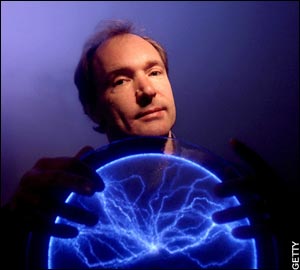
About 2 and a half years after he first submitted a proposal to his employer, CERN, for developing a new way of linking and sharing information at the European research institution, Tim Berners-Lee submits a formal proposal for a hypertext project he calls “WorldWideWeb”. In this proposal he lays out his vision for what will become the modern World Wide Web. By Christmas Day he will have the prototypes of a web server and web browser operational. By the end of February of the next year he will present the project to his colleagues at CERN. By May the first web server will go online internally at CERN. And by August, having realized the potential for his new system on the Internet at large, he will announce the project publicly on the alt.hypertext usenet group along with the first public web server hosted at CERN.
Ethernet is Born
November 11, 1973
As invented by Robert Metcalfe and David Boggs, an Ethernet network functions for the first time. From it’s humble beginnings as a research project at Xerox PARC, Ethernet has developed into the de facto standard for business and home networking.
The Day the Music Was Reborn
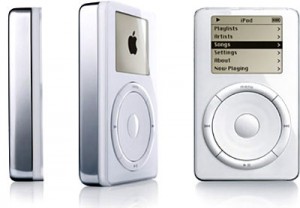
Apple ships the first iPod, the device that changed the course of both the music and technology industries. Of course, at the time, most “experts” could only focus on the fact that other devices cost less and may have had more impressive technical specs. Sort of like they do today. I guess when it comes to “experts” and Apple devices, they haven’t learned their lesson yet!
Microsoft Introduces Windows
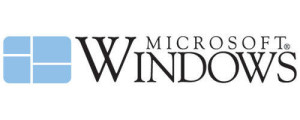
Microsoft formally announces Windows, a graphical user interface for Microsoft DOS-based systems. Bill Gates promises that Windows will ship by April of 1984. However, in true Microsoft fashion, Windows 1.0 doesn’t actually ship until November 1985. While Windows 1 and Windows 2 saw limited usage, it wasn’t until Windows version 3 that Windows began to see widespread acceptance.

